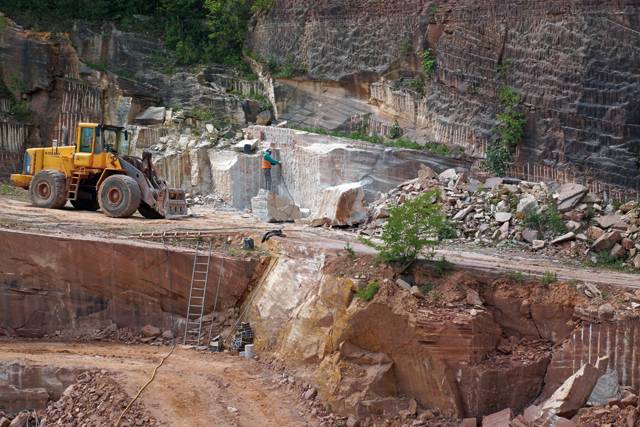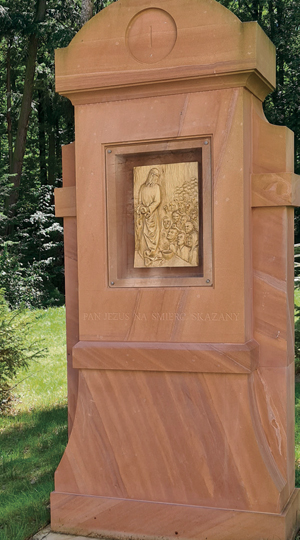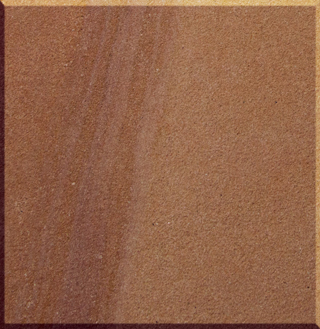TUMLIN – THE SHADES OF RED

The colours of the Tumlin sandstones are unique on global scale. Unique in any way. The Tumlin sandstone is globally unique; it cannot be replaced by any other stone. This is caused by very specific layering of this stone and its colour: from dark cherry-red, different red-rusty shades, to a very light bricky yellow.
The sandstone quarry Tumlin-Gród is one of the oldest quarries in the Kielce region. First written records on red sandstone quarrying in Góra Grodowa come from 1420, The current quarry has been in use since 1906. The stone there is quarried by natural methods without the use of explosives.
Tumlin used to be, and still is, a popular building and decorative material, and also export commodity that is used on façade elements: ledges, gables, door frames, stairs, as well as on pavements, and historical streets. You can find it in many buildings in the Świętokrzyskie region including the Palace of the Kraków Bishops in Kielce, in The Cathedral Basilica in Kielce, monastery in Karczówka, church in Tumlin, façades of residential and commercial buildings in Kielce, and in the streets Wesoła and Leonarda, and also on many other historical monuments in the whole region. It can also be found on the floor of the Franciscan Basilica in Cracow, on the façade of the Ministry of Foreign Affairs in Warsaw, and on the pavement near St. Stephen’s Church in Cracow. It is very often used regionally in small-scale architecture on private properties.

The Tumlin-Gród sandstone is very easy to break which enables acquiring of many elements from the broken stone. This is caused by its layering. An experienced stonemason can easily make 2 cm thick cut slab. Furthermore, the split surface is sometimes smooth enough so that it is possible to use it as cladding of flat surfaces without the need for further treatment. It does not have the tendency to peel off. It is normally used for outdoor purposes: cobble stones, kerbs, paving stones, wall cladding (cut and sanded), stone masoning material. The colour does not have the tendency to elute from the stone, nor to colour the neighbouring elements.
Although the layering is very distinct, its structure is compact, even monolithic – soft, middle-grained, thick, with siliceous-ferruginous-clay cement. It is worth mentioning that depending on the colour, the stone shows certain differences in its physical and mechanical characteristics.

The following chart therefore shows the results obtained for different coloured specimens – the result for darker colour of sandstone is described first.
The processing is not difficult. There are no hidden imperfections – caverns have not been detected. Similarly, as in other sandstones, it is worth the attention that cutting is done horizontally following the strata. This enables to keep better parameters of produced elements and nicer look – cutting through the layers makes them more visible.
It is easily and elegantly processable. Nevertheless, because of the variability of colours, it is scarcely used for sculpting. It still manages to find its supporters and you can find it in many burial sites and sacral buildings. For example, in 2019, the stations of the Cross in Prudnik were made from this material.
It is resistible to high temperatures. It was used as cladding for modern and historical furnaces. Also cladding resistible to acid and mill stones were made from it.
Even though the stones are variable in colour, they keep unifying colour tone. Thanks to that, if they are placed next to each other, for example on façades of buildings, they fit perfectly together and go well together visually as well.
Mechanically-physical information:
Volumetric mass density: 2410/2220 kg/m3
Porosity: 8.71 / 15.59%
Water absorption: 2.2 / 3.9%
Compressive strength:
– dry 128/69 MPa
– water saturated 91/46 MPa
Böhme method abrasion resistance 0.41 / 0.78 cm
Description
– colour ranging from dark red cherry to light brick red.
– Soft and medium grained
– hard, frost resistant
Characteristic features
– visible layering
– no substitutes
– unifying colour tone despite the variety of colours
– very rare structural defaults

Source: Kurier kamieniarski
Author: Kurier Kamieniarski | Published: 17.11.2020
